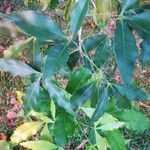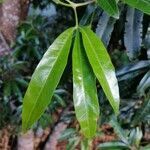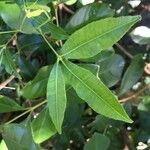Small tree or shrub, ± 5 m high. Leaves alternate, digitately 3-foliolate, gland-dotted; leaflets narrowly elliptic, 50-120 x 15-32 mm, glabrous; sometimes with crinkled margins, base tapering; petioles not winged. Flowers yellow, unisexual, in dense, terminal panicles. Calyx united at base, shortly 4-lobed. Petals (3)4, somewhat fleshy. Male flowers: stamens 8, without apical gland; ovary rudimentary, 2-4-angled, with 2-4 styles. Female flowers: staminodes 8, rudimentary; ovary 4-locular, with 2 ovules in each locule; style short; stigma peltate. Flowering time Dec.-Mar. Fruit 4-locular, with 1 or 2 ovules aborting; seeds solitary in locules.
Evergreen shrub or small tree, up to 5 m high. Leaves 3-foliolate, leaflets narrowly elliptic, 50-120 x 15-32 mm, apex acute or obtuse, margin undulate. Fruit 4-lobed, 4-5 mm in diameter. Flowers yellowish green.
Dioecious shrub or small tree to 5 m. Leaves trifoliolate, leaflets narrowly elliptic, undulate. Flowers unisexual, in terminal panicles, yellowish.
A tree.



